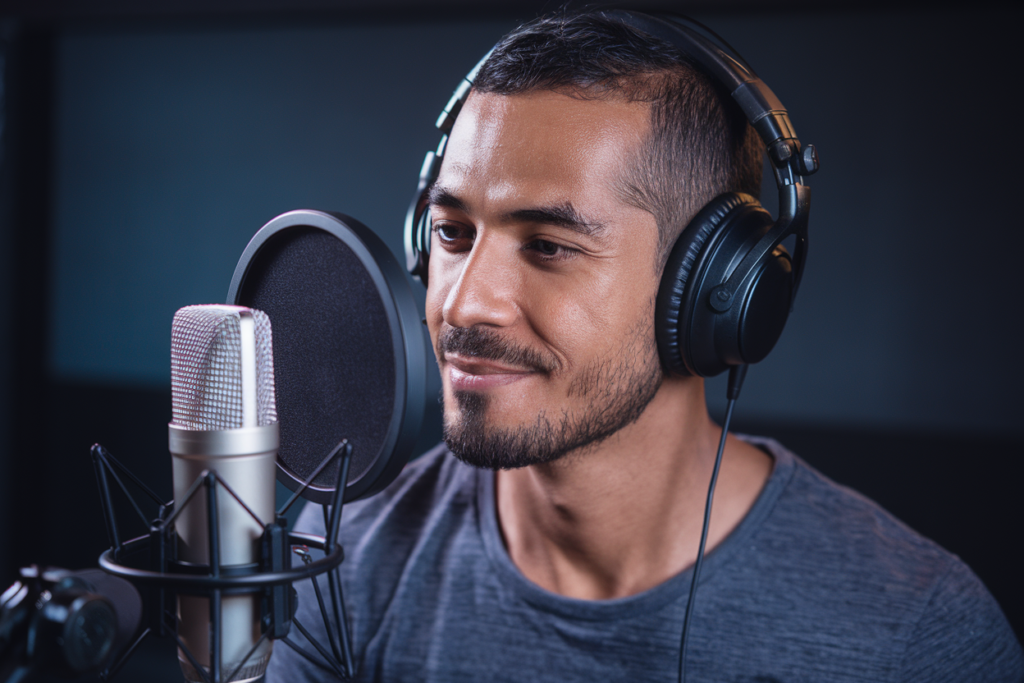Key Takeaways
- Significance of Timing: Perfect timing in Arabic dubbing is crucial for aligning dialogue with on-screen actions and conveying emotions effectively, enhancing viewer engagement.
- Cultural Nuances: Understanding and adapting to cultural differences is essential for voice actors to ensure humor and expressions resonate appropriately with the audience.
- Linguistic Challenges: The variety of Arabic dialects requires careful selection of words and sentence structures to maintain authenticity while syncing with visuals.
- Technical Tools: Utilizing software like Adobe Audition and Avid Pro Tools aids in achieving precise synchronization, improving overall dubbing quality.
- Performance Techniques: Voice actors should adjust pacing based on emotional context, incorporate strategic pauses, and practice variations in intonation for a more immersive experience.
- Collaboration Matters: Effective communication among translators, directors, and voice talents is key to overcoming challenges and delivering polished final products in Arabic dubbing.
Ever watched an Arabic dubbed movie and felt like something was off? It’s often the timing that makes or breaks the experience. Ensuring perfect timing in Arabic dubbing isn’t just about matching words to visuals; it’s about capturing emotions, humor, and cultural nuances that resonate with viewers.
The Importance of Timing in Arabic Dubbing
Timing plays a crucial role in Arabic dubbing, impacting the overall quality and effectiveness of the final product. When you think about it, perfect timing synchronizes dialogue with actions on screen. It ensures that emotions resonate strongly with your audience by aligning voiceovers seamlessly with visual cues.
Incorporating humor is another essential aspect where timing shines. A well-timed comedic line can elevate a scene, making it memorable for viewers. If the delivery lags or rushes, the intended humor may fall flat, leaving audiences disconnected from the experience.
Cultural nuances also hinge on precise timing. Certain phrases or expressions may carry different weights depending on when they’re delivered within a scene. A skilled voice artist understands these subtleties and adjusts their pace accordingly to maintain authenticity.
Voice talents must also consider pauses and intonations during dubbing sessions. Strategic pauses can build tension or allow moments to breathe, enhancing emotional impact. Effective voice actors adjust their performance based on this need for nuanced timing, creating an immersive atmosphere for listeners.
Ultimately, ensuring perfect timing in Arabic dubbing transforms content into engaging narratives that resonate deeply with audiences. Whether it’s capturing laughter or conveying drama through silence, timing makes all the difference in delivering a polished final product that captivates viewers.
Key Challenges in Arabic Dubbing
Perfect timing in Arabic dubbing faces several key challenges. These obstacles can impact the overall effectiveness of the final product, making it essential to navigate them carefully.
Cultural Nuances
Cultural nuances play a significant role in Arabic dubbing. Different cultures interpret phrases and expressions uniquely, meaning voice actors must adapt their delivery to convey the intended message accurately. For example, humor may not translate directly; what’s funny in one culture might fall flat in another. Understanding these subtleties helps voice talent infuse genuine emotion into their performances, ensuring that audiences connect with the content on a deeper level. Timing becomes crucial here—delivering a punchline at just the right moment can enhance its impact and resonate with viewers.
Linguistic Differences
Linguistic differences present another challenge for Arabic dubbing. The Arabic language features various dialects and regional variations that influence pronunciation and vocabulary usage. Voice artists must choose words that align with the intended audience while maintaining authenticity in tone and style. Additionally, sentence structures differ across languages, requiring careful adjustments to ensure dialogue syncs perfectly with visuals without sacrificing natural flow or emotional weight. This task demands skilled voice over talent who understand both linguistic intricacies and cultural contexts to create an immersive experience for viewers.
Navigating these challenges involves collaboration among translators, directors, and voice actors to achieve seamless integration of dialogue with visual storytelling. Each element contributes significantly to delivering engaging narratives that captivate audiences effectively.
Techniques for Ensuring Perfect Timing
Perfect timing is essential in Arabic dubbing, ensuring that dialogue aligns seamlessly with visual elements. Here are key techniques to achieve this goal.
Synchronizing Dialogue with Lip Movement
Synchronizing dialogue with lip movement creates a natural viewing experience. Voice actors must focus on matching their delivery to the characters’ mouth movements. This requires careful attention during recording sessions. Using software tools can help visualize timings and identify discrepancies between audio and visuals. By analyzing specific scenes frame by frame, you can fine-tune performances, making adjustments as necessary for a more realistic portrayal.
Adjusting for Pacing and Emotion
Adjusting pacing enhances emotional impact in dubbing projects. Different emotions require different speech rhythms; excitement might call for faster delivery, while sadness benefits from slower pacing. Voice artists should consider the emotional context of each scene when performing lines. Practicing variations in intonation and breath control adds depth to your performance, allowing viewers to connect deeply with the narrative. Listening to original performances helps inform decisions about how best to adapt pacing without losing the essence of the character’s emotions.
By employing these techniques, voice talents can ensure that timing resonates perfectly within each dubbed project, creating an engaging experience for audiences.
Tools and Software for Dubbing
Ensuring perfect timing in Arabic dubbing requires the right tools and software. These resources help voice actors synchronize their performances with on-screen actions, enhancing emotional delivery.
Popular Dubbing Software
Several popular dubbing software options facilitate seamless integration of dialogue and visuals.
- Adobe Audition: This audio editing software offers powerful tools for cleaning up recordings and adjusting sound levels, ensuring clarity in every line.
- Avid Pro Tools: Widely used in the industry, this platform provides advanced features for multi-track recording, making it easier to manage dialogues from various voice artists.
- Reaper: Known for its flexibility and affordability, Reaper allows you to customize your workspace according to your needs while supporting extensive plug-ins that enhance dubbing quality.
- Final Cut Pro: Ideal for those working with video content, this software streamlines the process of syncing audio tracks with visual elements effectively.
These tools empower voice talents to deliver high-quality performances that align perfectly with the visuals.
Innovation in Dubbing Technology
Innovation drives improvements in dubbing technology, fostering better synchronization and performance quality.
- Automated Lip Sync Technology: Advanced algorithms analyze mouth movements on-screen, helping voice actors match their dialogue timing precisely. This feature elevates viewer experience by creating a more immersive connection between characters’ emotions and spoken words.
- AI-Powered Voice Matching: Some cutting-edge applications utilize AI to match vocal tones of original performers. This technology enhances consistency across different languages while maintaining cultural nuances essential for effective storytelling.
By embracing these innovations, voice artists can elevate their work significantly, ensuring that every project resonates well with audiences while preserving the essence of the original material.
Best Practices for Dubbing Professionals
Ensuring perfect timing in Arabic dubbing requires a blend of skill, technology, and collaboration. Here are some best practices to enhance your dubbing projects:
- Understand the Source Material: Familiarize yourself with the original content. Knowing the tone, context, and emotional beats will help you adapt your performance effectively.
- Synchronize Dialogue Accurately: Pay close attention to lip movements during recording sessions. Use visual aids or software tools designed for timing synchronization to align your voice perfectly with on-screen actions.
- Adjust Pacing for Emotion: Different scenes evoke different feelings. Modify your speech rhythm based on the emotional intensity of each moment—slower pacing may work well for dramatic scenes, while faster delivery suits comedic moments.
- Practice Variations in Intonation: Experiment with pitch and emphasis during rehearsals. Subtle changes can dramatically alter how emotions resonate within a scene.
- Incorporate Pauses Strategically: Effective pauses can add weight to dialogue and allow audiences to absorb key moments fully. Don’t underestimate their impact.
- Collaborate Closely With Your Team: Communication between voice artists, translators, and directors is vital for achieving seamless integration of dialogue and visuals. Share insights that might enhance overall storytelling.
- Utilize Advanced Tools Effectively: Leverage industry-standard software like Adobe Audition or Avid Pro Tools to refine your recordings further; these tools offer features that improve synchronization quality significantly.
- Stay Updated on Innovations: Keep an eye on new technologies such as automated lip sync solutions or AI-powered enhancements that streamline the dubbing process while maintaining high-quality outcomes.
By implementing these practices, you’ll not only improve the quality of your work but also create memorable experiences that engage audiences deeply through effective Arabic dubbing techniques.
Conclusion
Perfect timing in Arabic dubbing is essential for delivering an immersive experience. By mastering synchronization and pacing you can evoke the intended emotions and humor that resonate with your audience. Embracing cultural nuances and leveraging advanced tools will enhance your dubbing quality.
As you continue to refine your skills remember that collaboration with voice artists translators and directors is key. Each project presents unique challenges but with dedication to timing techniques you can create impactful moments that leave a lasting impression on viewers. Your commitment to excellence in Arabic dubbing will not only elevate your work but also enrich the audience’s connection to the content.
Frequently Asked Questions
What are the main challenges of Arabic dubbing in movies?
Arabic dubbing faces challenges like matching dialogue to visuals, ensuring perfect timing for emotional delivery, and adapting performances to cultural nuances. Additionally, the varying dialects within the Arabic language complicate pronunciation and vocabulary choices.
Why is timing important in Arabic dubbing?
Timing is crucial because it affects how emotions and humor are conveyed. Proper synchronization of dialogue with on-screen actions enhances audience engagement and ensures that comedic moments land effectively.
How do dialects influence Arabic dubbing?
Different Arabic dialects can impact pronunciation and word choice, requiring voice actors to adjust their performances. This adaptability helps accurately convey intended messages across various regional audiences.
What tools are used in Arabic dubbing?
Tools like Adobe Audition and Avid Pro Tools are commonly used for improving synchronization and emotional delivery. Innovations such as automated lip sync technology and AI-powered voice matching also enhance performance quality.
What best practices should dubbing professionals follow?
Dubbing professionals should understand the source material, synchronize dialogue accurately, adjust pacing for impact, practice intonation variations, incorporate strategic pauses, and collaborate closely with translators and directors to achieve high-quality results.







